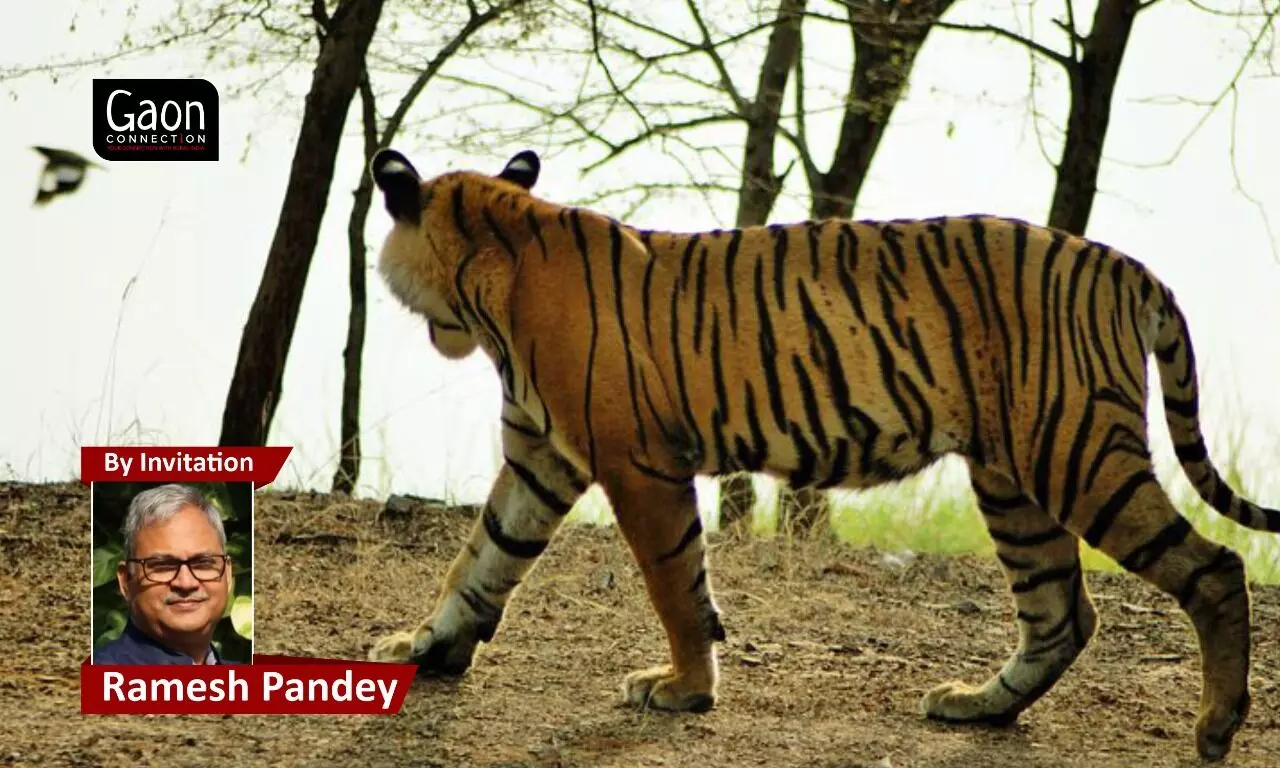The Tale of a Striped Monk
The tiger is a monk. It won't bother you, or be bothered by you. It tries to maintain its composure as much as it can. Even if you are around it, it will most likely be unfazed. And even when a tiger expresses its aggression, it is mock. It's a construct.
 Ramesh Pandey 29 July 2022 6:28 AM GMT
Ramesh Pandey 29 July 2022 6:28 AM GMT

The tiger is indeed charismatic, beautiful, magnificent, and powerful but being synonymous with aggression is not a right interpretation of its nature. All photos: Pixabay
The elegance of sighting a tiger in the wild is like sighting the Taj Mahal, which is beyond the capture of a mere photograph. More so, in the case of a tiger since the sighting of a tiger in its natural habitat is not only for a fleeting moment, but also very uncertain.
The elusive nature of the tiger, and the shroud of uncertainty around its character, led to its regard as a beastly or aggressive animal, in the general perception. This notion got further reinforced in the 'shikaar' tales of the British in colonial times.
Even Jim Corbett, having spent years eliminating man-eating tigers and leopards in Terai and Lower Himalayas, and narrating their stories, was only able to realise the hidden nature of the tiger in the fag end of his life. Having turned a new leaf and become a conservationist, he wrote that 'the tiger is a large hearted gentleman'.
Dunbar Branders, in his 1923 book Wild Animals of Central India, has also reflected on the true nature of the animal, but the then society was least concerned with the nature of the animal, and were more interested in shikaar tales. These reflections remained somewhat buried, until the 1970s and 1980s when the population of tigers dropped extremely low and the deliberations around its conservation started with the likes of Kailash Sankhla, author of Tiger! The Story of Indian Tiger, delving into its true nature.
It is interesting to see how the same animal embodies both the impressions of aggression and innocence at different times.
Also Read: The Saga of the Scarlet Semal
However, even in current times, a tiger brings to mind aggression, man-eating behaviour, killing, danger, and even violence – in general perception. For practitioners having spent years for the conservation of tigers, most commonly asked questions are typically around the killings, the attacks, the ferocious behaviour, and the aggression of tigers.
In villages of the Terai region, that are on the fringes of forests and protected areas, the current generation has been found to have antagonistic behaviour towards the tigers and seems to be totally indifferent or unaware about the true nature of the animals that they are around, tigers especially so.
When I see a tiger, it strikes me that it is a very self-engrossed animal. Even minor disturbances in its state of being, surprise it. An onlooker may sometimes wrongly perceive that a tiger is afraid or startled by a sudden interface but this is not its meekness or fear. Instead it is just occupied with its own self, its own tribulations.
It is interesting to see how the same animal embodies both the impressions of aggression and innocence at different times, both of which are incomplete realities of its nature.
That is why I say that the tiger is a monk. It won't bother you, or be bothered by you. It tries to maintain its composure as much as it can. Even if you are around it, it will most likely be unfazed. And even when a tiger expresses its aggression, it is mock. It's a construct. The reason I say this is that such tendencies or expressions of hostility on the part of a tiger usually depict anomalous behaviour – it is either sick, or old, or injured.
It is common to sight a tiger. What's rare is knowing a tiger and giving it its due respect and space, and that takes a lifetime.
Usually, cases of human-animal conflict only come to light when the animal is facing untoward human intervention or at the behest of disturbing agents. The tiger is indeed charismatic, beautiful, magnificent, and powerful but being synonymous with aggression is not a right interpretation of its nature.
This leads us to an important notion of respecting the tiger, and having admiration towards it, rather than demeaning, mobbing, or antagonising it as a species or in our interactions with it. In particular, when negative interfaces with tigers take place, many a times humans feel that their hypothetical position of superiority and dominance is challenged. They find their imaginary invincibility threatened and end up taking out their violent retaliation on the animal.
Having put ourselves on a greater pedestal than other creatures, humankind often forgets that their fellow animals too, have a psychological outlook, and an emotional space that deserves to be acknowledged and respected.
People need to change perceptions and realise that tigers are immaculately elusive and like to live a secluded, poised and meditative life. It is common to sight a tiger. What's rare is knowing a tiger and giving it its due respect and space, and that takes a lifetime.
Ramesh Pandey is an Indian Forest Service Officer who is currently Inspector General of Forests in MoEFCC, GoI at New Delhi. He has been awarded the UNEP Asia Environmental Enforcement Award. Views expressed are personal.
#International Tiger Day #story
More Stories




